Plate Tectonics is a scientific theory that describes the movement of the Earth’s lithosphere over mantle. This theory explains the formation of various geological features such as mountains, volcanoes, and earthquakes.
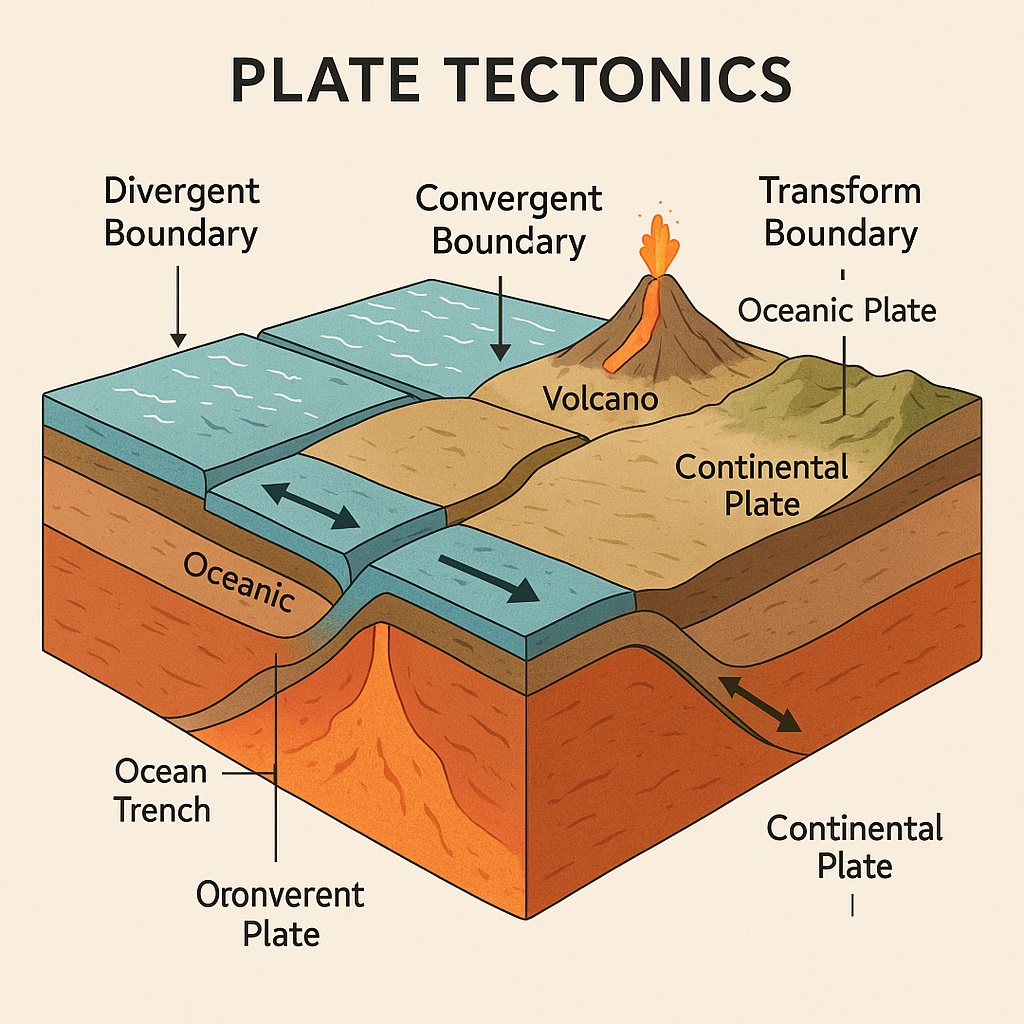
Table of Contents
What is Plate?
A tectonic plate is a massive, irregularly-shaped slab of solid rock, generally composed of both continental and oceanic lithosphere. The plate is actually parts of lithosphere. The thickness of plate is about 100 Km.
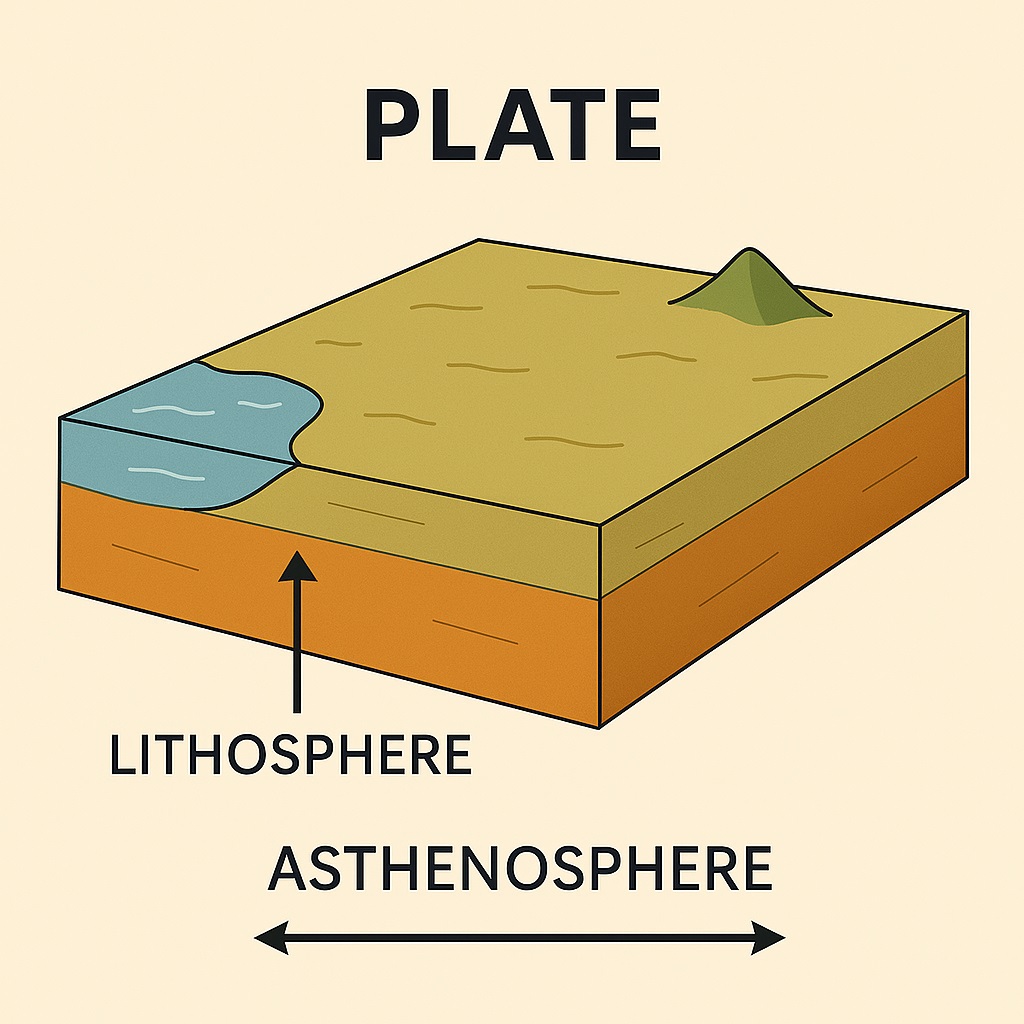
Major Plates
Major plates are the largest tectonic plates, covering vast areas of the Earth’s surface. These plates generally include both continental and oceanic crust and are responsible for the most significant tectonic activity, such as the formation of mountains, earthquakes, and volcanic eruptions.

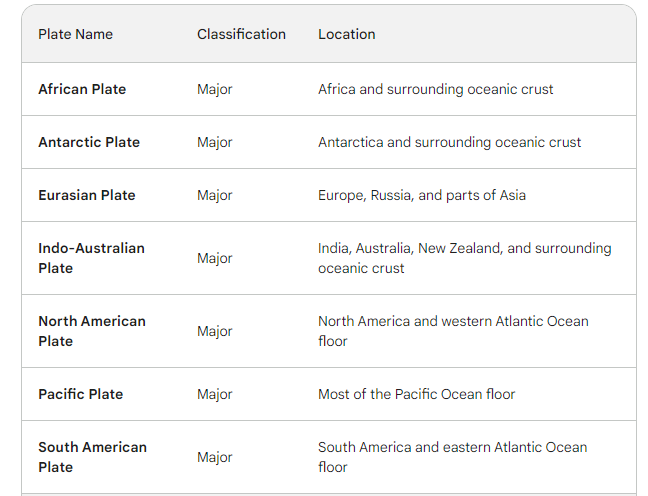
Minor Plates
Minor plates are smaller in area but still play an important role in tectonic activity. These plates may be entirely oceanic or a combination of oceanic and continental crust. Examples of minor plates:
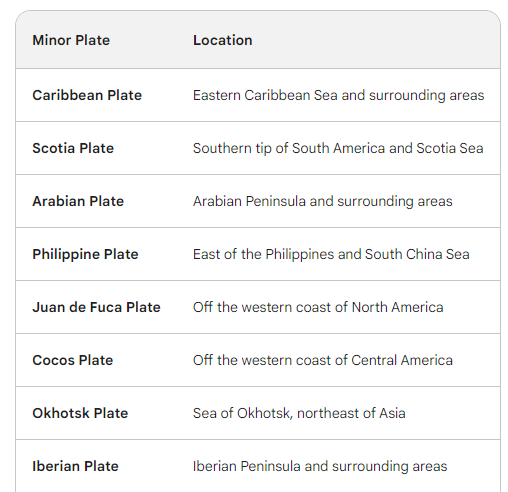
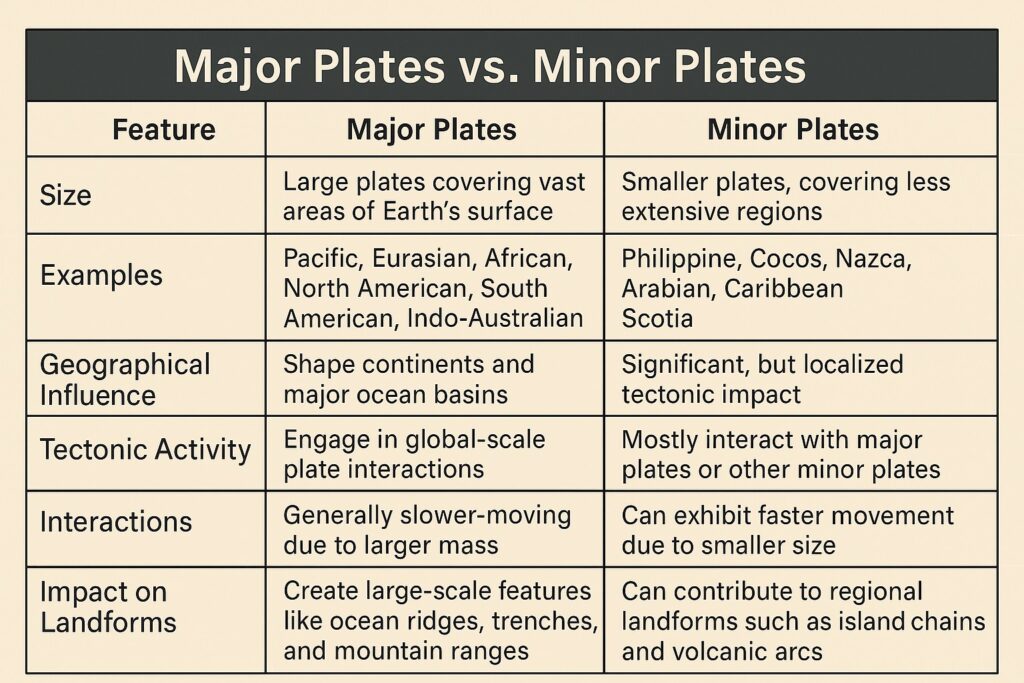
What is Plate Tectonics Theory?
The theory of plate tectonics proposes that the earth’s lithosphere is divided into seven major and some minor plates. Young Fold Mountain ridges, trenches, faults surround these major plates. These plates have been constantly moving over the globe throughout the history of the earth. The lithosphere moves over the asthenosphere. These tectonic plates move slowly—on average a few centimeters per year—but their cumulative effects over geological timescales are immense.
The lithosphere is divided into several major and minor plates, like the Eurasian Plate, African Plate, North American Plate, South American Plate, Pacific Plate, Indo-Australian Plate, and Antarctic Plate, among others.
According to plate tectonic theory the subducted portion of plate after reaching a depth of 100km or more starts melting due to high temperature prevailing in the upper mantle. The magma, thus formed, ascends and appears as volcanic eruption
Who proposed the Plate Tectonics Theory?
The Theory of Plate Tectonics was developed in the 1960s as a unifying model for Earth’s geological activity. It was not proposed by a single person, but rather evolved through contributions from multiple scientists based on earlier ideas like continental drift and seafloor spreading. Key contributors are: Wegener, Hess, Wilson, and others.
Origins and Development of the Theory
The concept of plate tectonics evolved from the earlier theory of continental drift, proposed by Alfred Wegener in 1912. Wegener suggested that continents were once joined in a supercontinent called Pangaea and have since drifted apart. However, his theory lacked a mechanism for movement.

In the mid-20th century, evidence from ocean floor mapping, paleomagnetism, and seafloor spreading—particularly studies at mid-ocean ridges—provided compelling support for the idea that the Earth’s crust was broken into plates. This gave birth to modern plate tectonics, a revolutionary idea that unified geology, geography, and geophysics.
Classification of Plate Boundaries
Three types of plate boundaries are: Convergent, Divergent and Transform.
Convergent
Convergent boundaries, also known as destructive margins, are zones where two tectonic plates move towards each other, leading to intense geological activity. This process is fundamental in Plate Tectonics, shaping Earth’s surface and driving the formation of mountains, volcanic arcs, deep-sea trenches, and earthquakes.
In the theory of plate tectonics, at a convergent boundary between a continental plate and an oceanic plate, the denser plate usually subducts underneath the less dense plate. It is well known that oceanic plate subduction under continental plates, and therefore oceanic plates are denser than continental plates. This subduction zone is also called Benioff Zone.
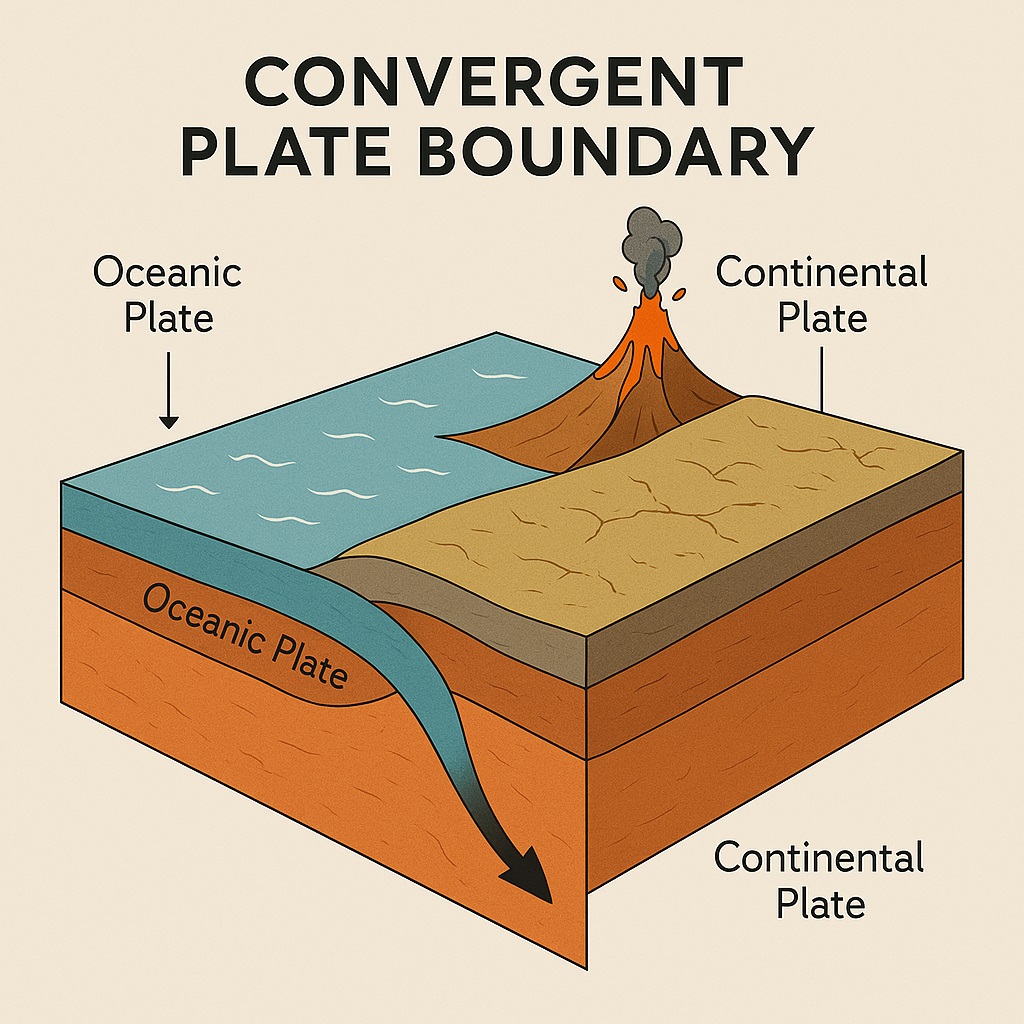
Types of Convergent Boundaries
Depending on the nature of the plates involved, convergence can occur in three different ways:
1. Oceanic-Continental Convergence
The denser oceanic plate subducts beneath the lighter continental plate. A subduction zone forms, creating a deep oceanic trench. Partial melting of the subducted plate leads to the formation of a volcanic arc.
Example 1: Andes Mountains (South America) and the Peru-Chile Trench
This is a classic example of Oceanic-Continental Convergence. The Nazca Plate (oceanic) is subducting beneath the South American Plate (continental). This ongoing collision is responsible for the Andes Mountain Range, frequent earthquakes, and numerous active volcanoes along the western edge of South America. The Peru-Chile Trench marks the subduction zone.
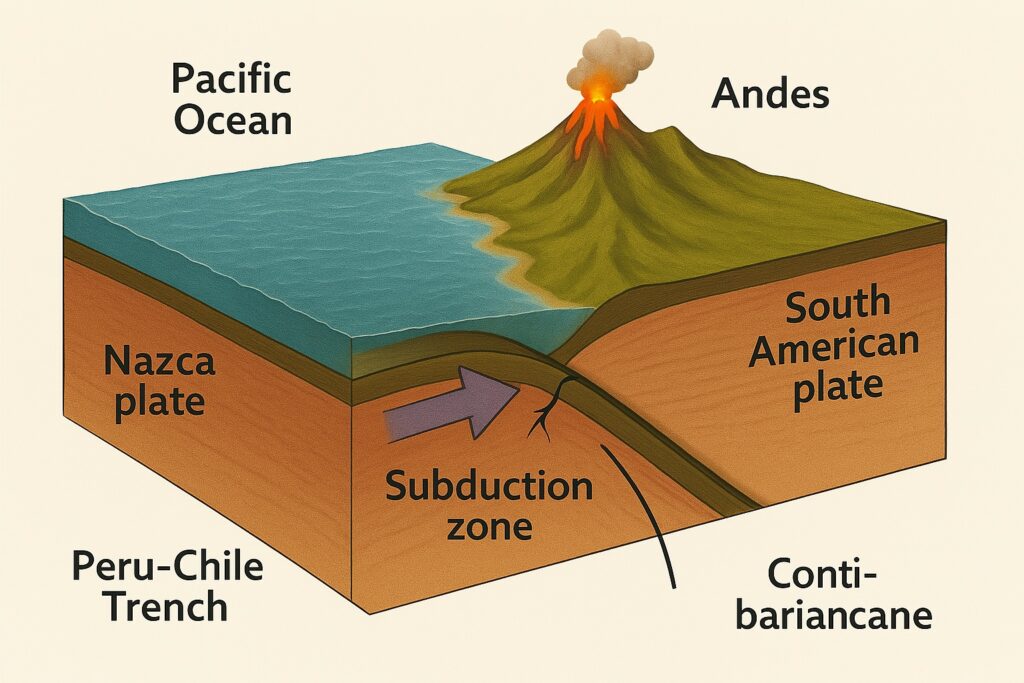
Example 2: Sunda Trench and the Barisan Mountains (Indonesia)
The Sunda Trench marks the boundary where the oceanic portion of the Indo-Australian Plate is forced beneath the overriding Sunda Plate (part of the Eurasian Plate system). In this process, the dense, cold oceanic lithosphere sinks into the mantle, creating a deep trench along the southern margin of Sumatra and Java. This continuous downward movement is driven by gravity and the overall convergent forces acting in the region. Frequent earthquakes and tsunamis are witnessed in this region.
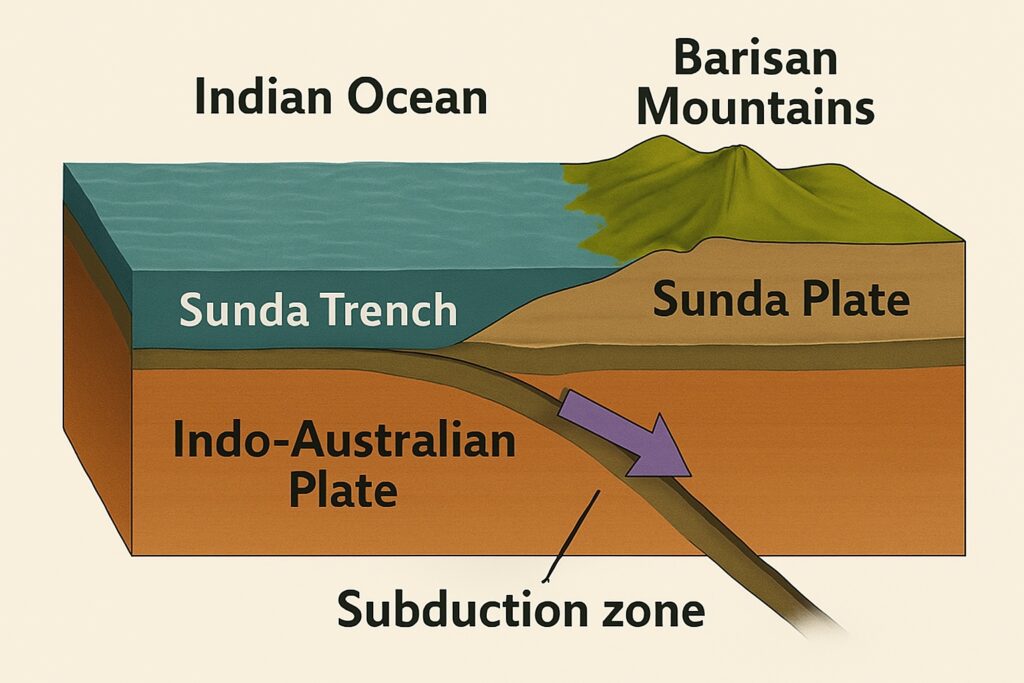
2. Oceanic-Oceanic Convergence
Oceanic–oceanic convergence occurs when two oceanic tectonic plates collide. Since both plates are made of relatively dense oceanic crust, one of them (denser) is forced beneath the other (less dense) into the mantle through a process called subduction. This subduction creates intense geological activity and distinct landforms beneath and above the ocean, forming a deep-sea trench. Volcanic activity leads to the creation of volcanic island arcs, such as the Mariana Islands in the Pacific Ocean. Frequent earthquakes occur due to intense tectonic activity.
Example: Formation of Mariana Trench
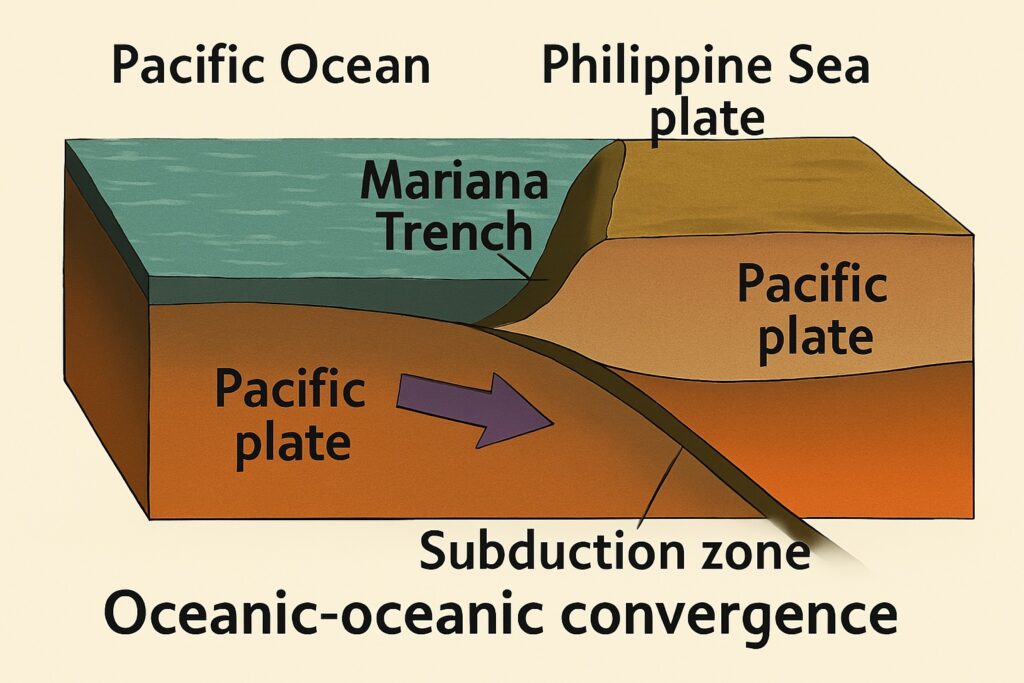
3. Continental-Continental Convergence
Continental–continental convergence occurs when two continental tectonic plates collide. Neither plate subducts due to their low density. Intense compression causes the crust to buckle and form mountain ranges, like the Himalayas, where the Indian and Eurasian plates collide. This process leads to fold mountains, strong earthquakes, and deformation of the lithosphere.
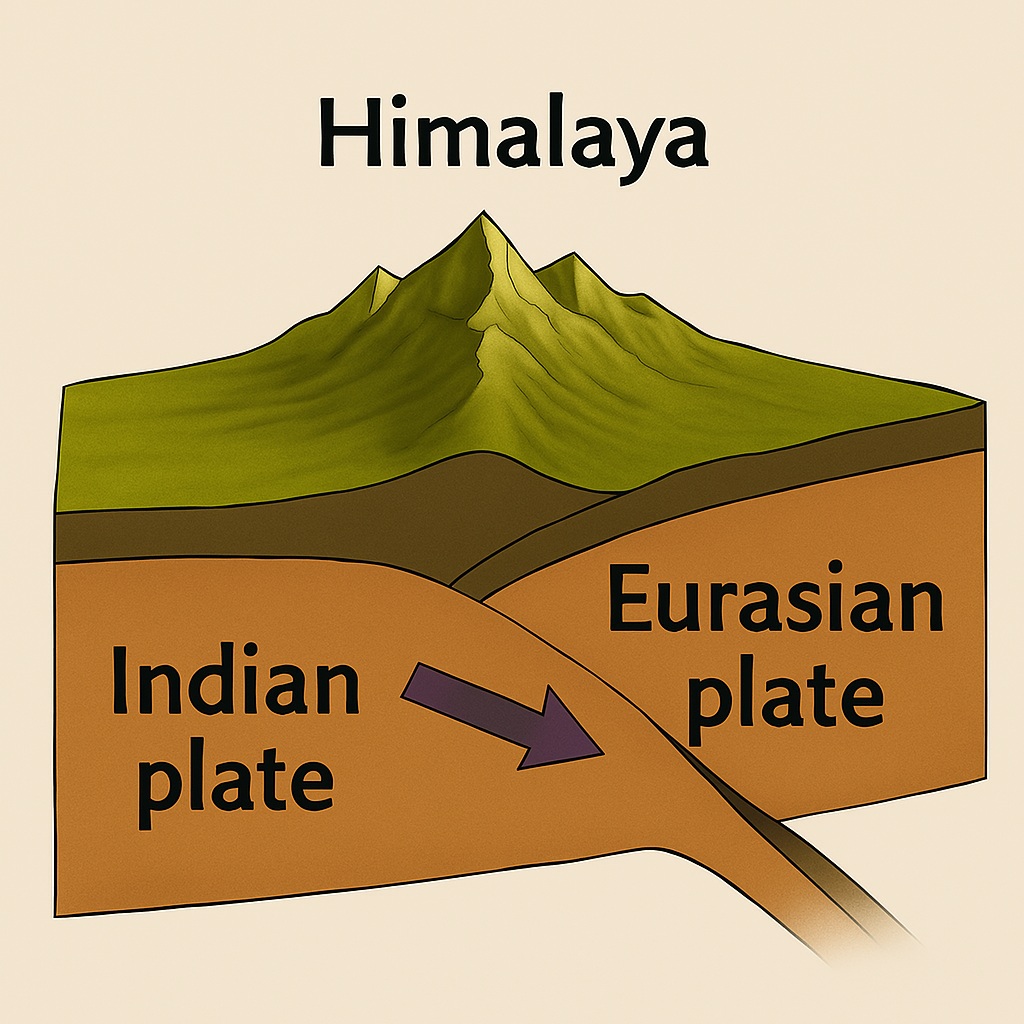
Divergent
In this boundary, the plates separate and the molten Magma comes on the surface, Active volcano is present in the divergent zone. The earth quake has shallow focus. There is a continuous formation of oceanic crust.
Example of Divergent Plate Boundary: A classic example of a divergent plate boundary is the Mid-Atlantic Ridge, which runs down the center of the Atlantic Ocean. Here, the Eurasian Plate and the North American Plate are moving apart, causing the Atlantic Ocean to slowly widen over millions of years. Divergent boundaries are often associated with volcanic activity and the formation of rift valleys and mid-ocean ridges.
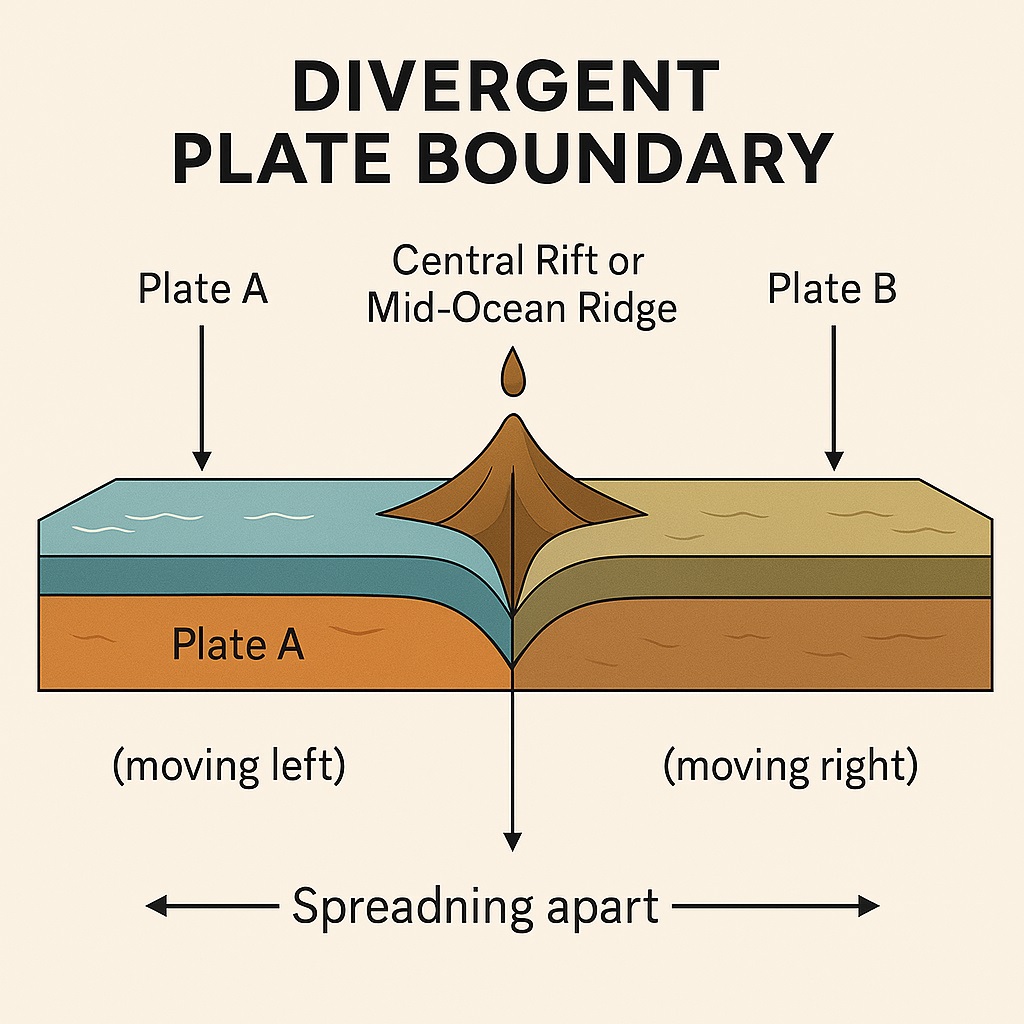
Transform
There is neither creation nor destruction along the transform fault. The plates slides laterally and there is no significant axial force. A transform boundary is a type of plate boundary where two tectonic plates slide past each other horizontally. Unlike divergent or convergent boundaries, there is no creation or destruction of the crust at transform boundaries, but the sliding motion can cause intense earthquakes.
Example: A well-known example of a transform boundary is the San Andreas Fault in California, where the Pacific Plate and the North American Plate move sideways relative to each other. This fault is famous for producing significant seismic activity due to the friction and stress built up as the plates grind past one another.
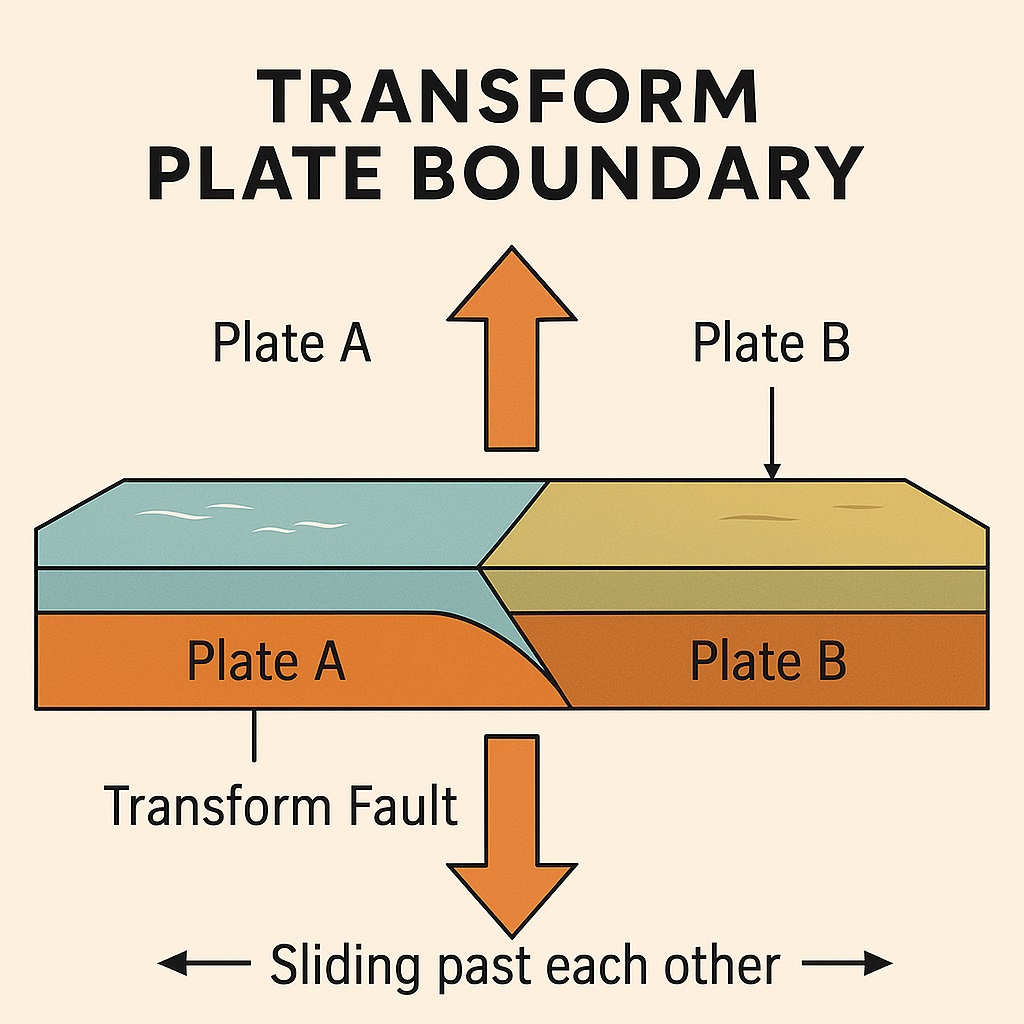
Movement of the Indian Plate
The Indian plate includes Peninsular India and the Australian continental portions. The subduction zone along the Himalayas forms the northern plate boundary in the form of continent— continent convergence.
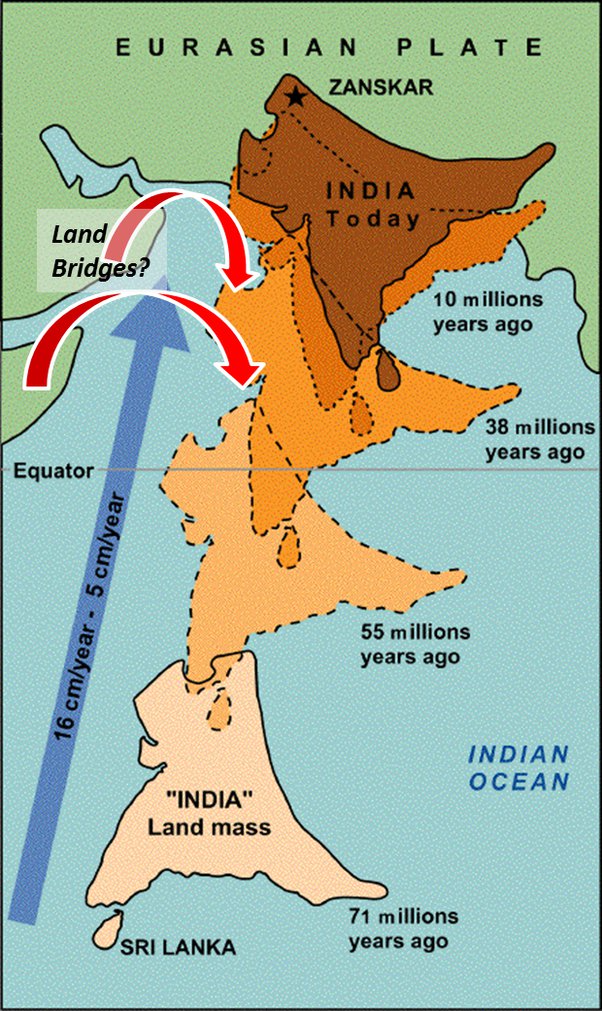
India was a large island situated off the Australian coast, in a vast ocean. The Tethys Sea separated it from the Asian continent till about 225 million years ago. India is supposed to have started her northward journey about 200 million years ago at the time when Pangaea broke. India collided with Asia about 40-50 million years ago causing rapid uplift of the Himalayas. About 140 million years before the present, the subcontinent was located as south as 50 S latitude.
The two major plates were separated by the Tethys Sea and the Tibetan block was closer to the Asiatic landmass. During the movement of the Indian plate towards the Asiatic plate, a major event that occurred was the outpouring of lava and formation of the Deccan Traps. This started somewhere around 60 million years ago and continued for a long period of time.
Who is moving theses Plates?
The fact that the plates move is now a well-accepted fact. The mobile rock beneath the rigid plates is believed to be moving in a circular manner. The heated material rises to the surface, spreads and begins to cool, and then sinks back into deeper depths.
This cycle is repeated over and over to generate what scientists call a convection cell. Heat within the earth comes from two main sources: radioactive decay and residual heat. Arthur Holmes first considered this idea in the 1930s, which later influenced Harry Hess’ thinking about seafloor spreading.
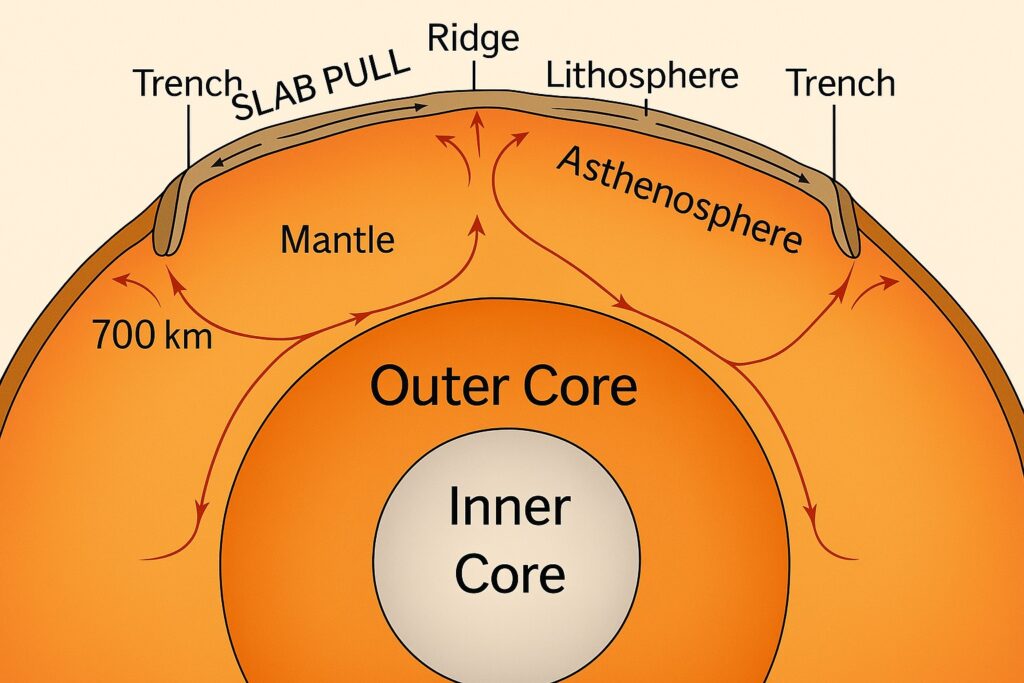
Evaluation of the Plate Tectonic Theory
- While the lateral extent of modern plate can be easily defined by earthquake activity, its thickness is not physically defined. This lack of definition makes it difficult to understand how plates move.
- The physical feature on the east and west of Pacific Ocean indicates that the Pacific plate moves to the east and west at the same time, being a rigid landmass it is not feasible.
- The theory remains silent on the origin of plates.
- Today, radioactivity is provided as the mechanism for both convection and the existing amount of heat in the core. However, there is no evidence to support the existence of radioactivity below the upper mantle. If radioactivity represented the driving force for convection, then why don’t we observe large amounts of radioactive elements in deep-seated volcanic eruptions (so called hot spots)?
- It is difficult to imagine how a ridge over the rising limb of a mantle convection cell would be carried down on the descending limb of the same cell.
- The force balances suggest that it is physically impossible for subduction to occur.
- Plate tectonics cannot adequately explain the configuration or large number of volcanoes (seamounts and guyots) in the Pacific basin.